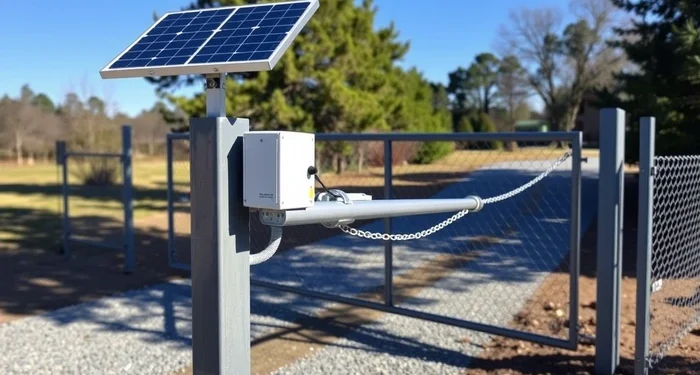Driveway gates serve as the first line of security, privacy, and convenience for residential and rural properties. However, traditional electric gate openers often rely on constant access to grid power, which may not be practical or efficient—especially in remote areas or regions with unreliable electricity. Enter the practical solution: solar powered gate openers.
This article explores how you can improve the energy efficiency of your driveway gate system through solar technology, helping you reduce operational costs, minimize environmental impact, and maintain everyday convenience. Whether you’re looking for sustainable driveway gate ideas, or simply trying to understand how a remote gate opener works with solar energy, this comprehensive guide offers a balanced, real-world approach.
1. What Is a Solar Powered Gate Opener?
A solar gate opener is an automatic system powered primarily by solar panels, used to operate swing or sliding driveway gates. Unlike conventional openers that rely on electrical wiring from the house or nearby infrastructure, solar systems generate energy independently from sunlight and store it in a battery.
Main Components include:
- Solar panel(s) – capture sunlight and convert it into electricity.
- Battery – stores energy to operate the gate during cloudy days or nighttime.
- Control box – manages gate logic and motor functions.
- Actuator or motor – physically opens or closes the gate.
- Remote access system – wireless fobs, keypads, or sensors.
This setup is ideal for rural properties, long driveways, off-grid homes, or those looking to cut utility dependency.
2. Why Choose a Solar Gate Opener? Key Benefits
Switching to solar for your driveway gate is more than an environmental decision—it can be a practical one too.
Lower Energy Costs
Electric gate systems can draw significant power, especially with frequent use. Over time, using solar reduces this electricity demand, leading to noticeable savings on utility bills.
Suitable for Remote Locations
If your gate is far from the main building, running underground power lines can be expensive and labor-intensive. Solar systems eliminate the need for trenching and cabling.
Battery Backup During Power Outages
Solar systems store excess energy in batteries, offering reliable operation even during blackouts—a benefit that standard electric systems don’t provide without a backup generator.
Minimal Operational Noise
Solar gate openers often run quieter than conventional systems, depending on the motor and setup. This is an appreciated feature in residential or wildlife-heavy areas.
3. Solar System Requirements: Matching Panel Size to Use
Choosing the right solar powered gate opener starts with estimating power needs. Factors that affect your solar setup include:
- Gate weight and size: Heavier gates need stronger motors and more power.
- Frequency of use: A gate opened 10+ times per day will need a larger battery and panel than one used occasionally.
- Climate and sun exposure: More sunshine equals more consistent power; shaded or cloudy areas may need larger or multiple panels.
Typical Setup Example:
- 10W–20W solar panel (for light residential use)
- 12V deep-cycle battery
- Controller board and linear actuator for single swing gate
For dual swing gates or frequent access points, a 30W–40W panel and upgraded battery system may be necessary. Always confirm compatibility with manufacturer specifications.
4. Manual vs. Remote vs. Smart Operation: Which Is Right for You?
Modern remote gate openers come with varying levels of control and accessibility. The type of user experience you want will guide which control systems to pair with your solar setup.
Manual Control
- Operated via keypad or physical switch
- No wireless connection needed
- Most affordable and reliable option
Remote Access
- Handheld remote key fobs
- Standard with most modern kits
- Allows gate control from inside a vehicle
Smart Controls (Optional)
- Wi-Fi or Bluetooth enabled
- Can integrate with smart home platforms
- Some systems allow control from mobile apps or link to intercom systems
If you’re focused on energy efficiency and simplicity, manual or basic remote systems are often more reliable and consume less energy than smart configurations.
5. Compatible Gate Types for Solar Operation
Not every gate style is equally suited for solar operation. Here’s how to match your driveway gate ideas to a solar system:
Swing Gates
- Most common and easiest to automate
- Single or dual leaf configurations
- Must account for gate angle and hinge resistance
Sliding Gates
- Require a track or guide rail
- Typically heavier and need more power to start motion
- Work well with larger solar systems
Farm-Style or Tube Gates
- Lightweight and ideal for rural or low-traffic entrances
- Minimal resistance reduces battery drain
Proper gate alignment, lubrication, and balance are essential to maximize efficiency regardless of style.
6. Installation Tips for Solar Gate Openers
If you’re planning to install a solar gate system yourself, here are some practical considerations to ensure reliability and safety.
Position the Solar Panel Correctly
- Aim for south-facing exposure (in the northern hemisphere)
- Avoid tree shading or building shadows
- Tilt the panel to optimize seasonal sunlight (30–45° angle is common)
Mount the Control Box in a Dry, Secure Location
- Protect from water and rodents
- Ensure ventilation to prevent overheating
Use High-Quality Battery Terminals and Wiring
- Poor connections reduce charging efficiency
- Corrosion can shorten system life
Anchor Gate Posts and Motors Firmly
- Posts should be set in concrete
- Loose hinges or posts increase strain on motors and battery
7. Maintenance and Lifespan Expectations
While solar gate openers are low-maintenance compared to traditional systems, occasional upkeep helps ensure years of smooth operation.
Monthly Checks:
- Clear solar panels of dust, bird droppings, or leaves
- Inspect battery connections and terminals
Quarterly Tasks:
- Lubricate gate hinges and actuators
- Check for moisture or signs of wear inside the control box
- Test open/close cycle under load
Battery Life:
- Typically lasts 3–5 years depending on climate and usage
- Replace with deep-cycle, sealed AGM or lithium batteries for best results
8. Practical Design Tips to Maximize Efficiency
Boost your solar gate’s performance without increasing cost by considering these layout tips:
- Install the gate closer to your home if possible — reduces travel time and increases visibility
- Use light-colored paint on the panel mount — helps reduce heat buildup
- Include a manual override — essential during mechanical failure or maintenance
- Add a low-power motion sensor or loop detector — triggers opening automatically for vehicles without draining the battery
These additions can increase ease of use while keeping the system energy-efficient.
9. Budget Considerations: How Much Should You Expect to Spend?
Entry-Level Kits:
- Cost: $300–$500
- Suitable for light, single swing gates
- Includes 10W solar panel, one actuator, control board, and remote
Mid-Tier Kits:
- Cost: $600–$900
- Dual gate compatibility
- Larger solar panels, upgraded battery, and more durable hardware
Professional or Heavy-Duty Kits:
- Cost: $1,000–$1,500
- Designed for high-traffic or heavy gates
- Often includes additional safety features like soft start/stop, auto close timers, etc.
DIY installation can save $200–$400 compared to hiring an installer, provided you have basic tools and electrical knowledge.
10. Environmental Consideration and Property Value
Using a solar powered gate opener isn’t just a practical choice—it can align with eco-conscious living and even increase the resale appeal of a property.
- Lower carbon footprint: Reduced reliance on fossil-fueled power generation.
- Off-grid capability: Makes your property more resilient and autonomous.
- Increased resale appeal: Buyers appreciate energy-saving features and security.
Whether you’re operating a working farm, remote home, or modern suburban residence, a solar gate can demonstrate long-term thinking and efficient design.
Read Also: How Automation Is Transforming Cell Line Development
Conclusion: Solar Energy Makes Sense for Today’s Gate Systems
For property owners looking to reduce energy use while improving access, safety, and convenience, solar powered gate openers offer a reliable and sustainable option. By choosing the right components, aligning them to your gate’s specific demands, and following best practices for installation and maintenance, you can enjoy years of dependable performance without added utility costs.
From driveway gate ideas to smart remote gate opener systems, energy-efficient gate design doesn’t need to be complicated or expensive. With solar power, you can meet everyday demands using one of the most accessible and cost-effective renewable resources available: sunlight.











